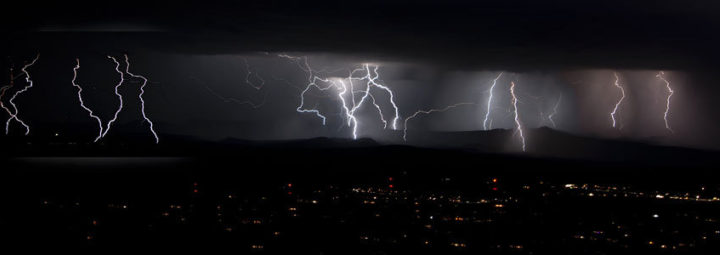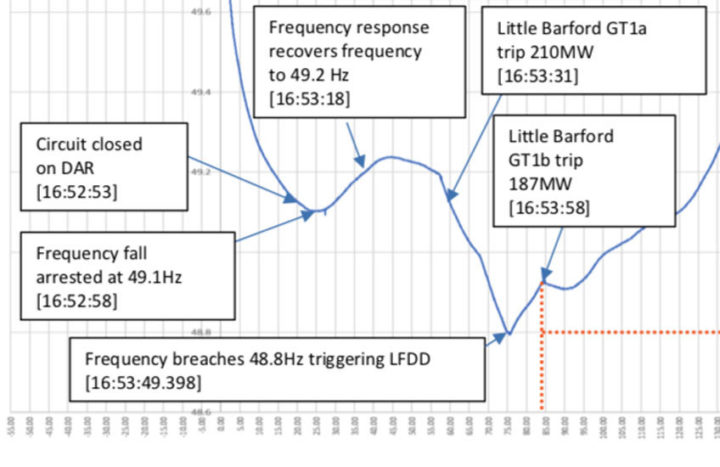Powercut: A 10-year failure to act?
New report on 9th August event due to ask questions about regulator's lack of action
By Richard Black
Share
Last updated:
Tuesday sees publication of the second, more detailed report from the operator of Britain’s electricity system, National Grid-ESO, to regulator Ofgem on the power cut that hit a million homes and parts of the rail network exactly a month ago.
Grid’s initial report documented some of the important factors involved. But it stopped short of detailing chains of causality, responsibilities and remedies. This week’s report is expected to close at least some of the gaps in that knowledge landscape.

It’s likely to major on the three sources of generation that went offline – the gas-fired power station at Little Barford in Cambridgeshire, the Hornsea One windfarm off the east coast, and the myriad small generators ‘embedded’ in regional electricity distribution networks.
Because if any one of these three hadn’t failed, we probably wouldn’t have had a power cut.
And in at least one of the three cases, there is a strong case for arguing the failure was entirely predictable, and that the industry and its regulator have been remiss over the last decade in failing to get it fixed.
Lighning spark
First, Hornsea One.
Grid’s initial report was pretty explicit that the windfarm’s automated protection system was in a highly sensitive mode, such that it tripped out when lightning struck a power line more than 100km away.
It said that engineers had deciphered the fault and that Hornsea One ‘…is now operating robustly to such millisecond events.’
Which is fine – but we don’t know the nature of the faulty setting, nor why it was set up in this condition.

This may turn out to be interesting not because it could have been predicted but because it’s the first of its kind. If so, it will help wind farm operators avoid such trip-outs in future.
The Little Barford shutdown may turn out to have a rather more direct relationship to the lightning strike which, it’s pretty clear, was the initial trigger to the whole cascade of events.
We know the strike happened near Eaton Socon in Cambridgeshire, on a power line running to Wymondley in Hertfordshire.
There is a big substation complex at Eaton Socon where power from the National Grid flows into the lower-voltage regional distribution system run by UK Power Networks (UKPN). This is physically close to Little Barford.
The gas-fired power station started to shut down after the automated control system of its steam turbine registered ‘anomalous’ speed readings. Industry sources suggest the most likely cause is a disruption to the power station’s own electricity supply.
So, did the lightning strike directly hit lines providing power to the station?
In addition, UKPN is in the midst of a major upgrade to its distribution network in this area. Replacing 40-year-old substation equipment, re-routing power lines – that kind of thing. Could this have made the local electricity supply less resilient than it would have been normally?
Local focus
While questions surround the shutdowns of those two sources of generation, we understand far more about the third – the automated shutdown of thousands of smaller generators ‘embedded’ in regional distribution networks rather than connected to National Grid.
We understand it because it’s happened before – not least on 27thMay 2008, the last time the UK had a power cut caused by generation faults.
Then, Longannet coal-fired power station and Sizewell B nuclear reactor abruptly shut off power into the grid, for unrelated reasons, within five minutes of each other. This caused the frequency of the grid to fall.

Thousands of embedded generators around the country detected this, sensed a possible fault, and automatically shut down.
The amount of generation lost this way was, at 406MW, greater than that coming from Longannet.
The generators had been fitted with systems designed to switch them off protectively if there is a fault in the network nearby.
They work either by sensing the rate at which the grid frequency is falling – ‘Rate of Change of Frequency’, or ‘RoCoF’ – or by a shift in the phase of the electrical waveform – ‘Vector Shift’ or ‘VS’.
In the 2008 event, both types of system were activated by the change in frequency and phase in the national network caused by the Longannet and Sizewell outages. In shutting down, they made the problem worse.
Investigating that incident, National Grid detailed its ‘…concern that embedded generation protected by Rate of Change of Frequency (RoCoF) protection could trip following a large generation loss. The effect of such RoCoF trips could aggravate the resulting frequency change following the loss and have an adverse effect on normal frequency recovery.’
To adapt a phrase invented by one long-term industry professional: overly sensitive RoCoF and VS transformed the fall of a single cyclist into a collapse of the whole peloton.
A decade going backwards
Some steps have been taken to address the situation. In 2014, work started to change RoCoF settings for the biggest embedded generators, making them far less sensitive. New generators have to use the less sensitive setting, and VS is banned for them.
But the bulk of older generators have yet to be updated… and won’t be until 2022.
As last month’s powercut shows, this has left us with a system that is if anything more vulnerable than it was a decade ago. In the 2008 event, 400MW of embedded generation went offline – in August 2019, 500MW.
And the risk could be much higher than that. The Electricity Networks Association, which represents the distribution companies, estimates there could be as much as 15GW of small-scale generation fitted by over-sensitive RoCoF or outmoded Vector Shift systems.
How has this been allowed to happen? It wasn’t allowed to happen in Germany, where regulators realised in 2005 that they had an analogous problem affecting about twice as much generating capacity as in the UK. It has already been fixed.
One clue to the delay comes in a 2017 report from Ofgem which notes that a committee set up by the DNOs four years previously to recommend a solution had had 37 meetings but ‘…has not yet fully discharged the terms of reference.’
Regulatory fail?
Whatever the minutiae, one thing is clear: Ofgem, the regulator, hasn’t pushed the DNOs to solve the problem. In fact, as noted, consumers appear to be more exposed to RoCoF risk than we were a decade ago.
In a regulated monopoly, which is what we have with electricity transmission and distribution in this country, the regulator has to be the arm of the consumer. Yet here, Ofgem has known about the problem and the size of the risk for a decade and has not ensured it was fixed.
How hard this will be flagged in the report isn’t clear. National Grid, the DNOs and the generators are all regulated by Ofgem, so may be reluctant to point the finger.
And as I noted previously, one of the oddest aspects of the sequence of investigations concerning last month’s powercut is that in this failure of a regulated industry, the regulator is the one party not being investigated.
Endpoints
Finally, a bit of context and a thought.
There are something like 200,000 power cuts in the UK each year. The vast majority are caused by faults in the distribution networks. These can be technical faults, human error or natural hazard: for example, the very day after the 9thAugust power cut, households in Wales were cut off by storm and rain.
Faults caused by problems with generation are vanishingly rare – this was the first since 2008.
And a thought… if language matters, let’s not call this a ‘blackout’. Because it really wasn’t.
Households lost power for between 10 and 45 minutes, at a time of day when the sun was in any case providing copious amounts of light.
‘Temporary brownout’, then, if you must – although it’s hard to see anything wrong with the common-or-garden term ‘powercut’.
Unfortunately, there is a long and not very honourable history of climate and energy contrarians using the term ‘blackout’, deliberately, to recall the three-day week of the 1970s and pretend that the switch to zero-carbon generation is going to bring equivalent levels of disruption.
So yes... language matters.
Share